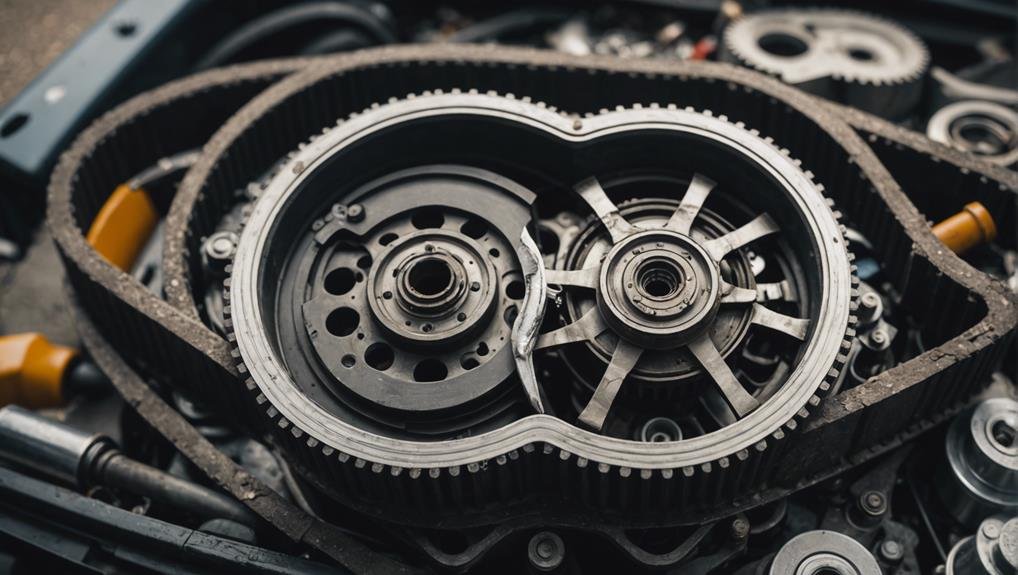When your car's timing belt wears out or becomes damaged, it can disrupt the delicate synchronization of your engine's valves and pistons, leading to a range of symptoms that can cause poor engine performance, decreased fuel efficiency, and even costly repairs if left unaddressed. You may notice engine misfires and rough idling, unusual noises from the engine, difficulty starting the engine, or visible signs of wear and damage on the belt. If you're experiencing any of these symptoms, it's essential to address the issue promptly to prevent engine damage. By exploring further, you'll uncover more details on how to identify and fix timing belt problems before they cause catastrophic damage.
Key Takeaways
- A bad timing belt can cause engine misfires, rough idling, and inconsistent RPMs due to disrupted valve and piston synchronization.
- Unusual noises like ticking, clicking, or squealing sounds from the engine indicate timing belt issues that require immediate inspection.
- Difficulty starting the engine, sluggish acceleration, and reduced power are symptoms of a worn timing belt affecting engine ignition timing.
- Visible signs of wear and damage, such as cracks, fraying, or wear on the belt, can lead to costly repairs if not addressed promptly.
- Ignoring symptoms of a bad timing belt can lead to severe engine damage, safety concerns, and expensive repairs, making timely replacement crucial.
Engine Misfires and Rough Idling
When your engine starts misfiring and idling rough, it could be a sign that your timing belt is worn out, disrupting the delicate synchronization of valves and pistons. This critical component guarantees that the engine's valves open and close in harmony with the pistons, allowing for a smooth and efficient combustion process.
However, when the timing belt wears out, this synchronization is disrupted, leading to engine misfires and rough idling. As the belt stretches or cracks, the valves and pistons can collide, causing the engine to misfire and idle rough. This can result in inconsistent RPMs, shaking, and unusual sounds, which can be alarming and affect your driving experience.
If left unchecked, a worn-out timing belt can lead to further engine performance issues, potentially causing damage to your engine. It's crucial to address these symptoms promptly to prevent more severe problems from developing. By recognizing the signs of a bad timing belt, you can take proactive steps to maintain your engine's health and avoid costly repairs down the road.
Unusual Noises From the Engine
One telltale sign of a bad timing belt is the unusual noises emanating from your engine, which can manifest as ticking or clicking sounds that indicate a synchronization issue. As the timing belt wears out, it can cause the engine's components to fall out of sync, resulting in these unusual noises. Ignoring these signs can lead to costly repairs and even engine damage.
Here are three key things to keep in mind:
- Ticking noise: A loose belt, worn teeth, or low oil pressure due to timing belt issues can cause ticking sounds.
- Engine signs: If you notice unusual noises, it's crucial to inspect your timing belt immediately to prevent further damage.
- Replace promptly: If you find any issues, replace the timing belt as soon as possible to avoid engine damage and costly repairs.
Difficulty Starting the Engine

If you're having trouble starting your engine, it may be a sign that your timing belt is on its way out. A worn timing belt can lead to difficulty starting the engine, and it's important to address the issue promptly. The timing belt plays a critical role in synchronizing engine functions, and when it's damaged, it can affect engine ignition timing, causing starting problems.
If the timing belt is damaged, the engine may struggle to start properly, leaving you stranded. You may notice that your engine takes longer to start or requires multiple attempts to turn over. In some cases, the engine may not start at all. These issues can be frustrating and stressful, especially if you're not sure what's causing the problem.
However, if you're experiencing difficulty starting your engine, it's vital to explore the timing belt as a potential culprit. Consulting a professional is recommended if you're experiencing engine starting issues related to the timing belt. They can diagnose the problem and recommend the necessary repairs to get your engine running smoothly again.
Don't ignore the signs – address the issue promptly to avoid more severe problems down the road.
Visible Signs of Wear and Damage
Inspecting your timing belt regularly can help you identify visible signs of wear and damage, potentially saving you from costly repairs down the road. As you inspect your timing belt, look for common signs of wear, such as cracks, fraying, or visible wear on the belt. These signs can indicate a worn-out timing belt that's on the verge of failing.
Here are three key signs to watch out for:
- Belt Wear: Missing teeth or shiny spots on the belt can signal wear and imminent failure.
- Oil Leak: Oil or coolant contamination on the belt can deteriorate its material and weaken it.
- Fraying or Cracks: Cracks, fraying, or visible wear on the timing belt indicate potential damage.
If you notice any of these signs, addressing the issue promptly is crucial to avoid engine damage. A failing timing belt can cause ticking or rattling noises, and if left unchecked, can lead to more severe problems.
Smoke or Fumes After Starting

Recognizing the signs of a failing timing belt is crucial to addressing timing belt issues promptly and preventing more extensive repairs and costly fixes.
By being proactive and taking action when you notice smoke or fumes after starting your engine, you can maintain your vehicle's performance and longevity.
Timing belt wear can lead to fuel composition issues, causing poor fuel combustion and visible smoke or fumes, which can result in further damage and more severe problems if ignored.
When your timing belt is worn out, it can disrupt the synchronization of your engine's valves and pistons, leading to improper combustion and excessive smoke or fumes emanating from your exhaust pipe.
This clear indication that your timing belt needs replacement emphasizes the importance of proactive maintenance to ensure your vehicle's optimal functioning.
Loss of Power and Performance
As you continue to drive with a worn timing belt, you'll likely notice a decline in your vehicle's responsiveness, marked by a loss of power and performance. This is because a poor timing belt condition can lead to engine misfires, resulting in reduced power output. You may struggle to accelerate quickly, and your engine may struggle to reach peak RPMs, delivering less power when you need it.
Here are three key signs of a timing belt-related loss of power and performance:
- Sluggish acceleration: If your vehicle takes longer than usual to accelerate, it could be a sign that your timing belt is worn out.
- Reduced power output: If your engine is misfiring, it can lead to a significant decrease in power output, making it harder to drive uphill or merge onto a busy highway.
- Difficulty reaching peak RPMs: A bad timing belt can cause your engine to struggle to reach the peak RPM range, leading to poor performance and decreased fuel efficiency.
It's crucial to address these issues promptly to prevent further damage to your engine. Remember, a failing timing belt requires immediate attention to avoid costly repairs down the road.
Oil Leaks and Stains Underneath

Oil leaks and stains underneath your vehicle can signal a failing timing belt, which may be caused by worn or cracked gaskets near the timing belt cover. These leaks can lead to engine overheating, which can result in costly repairs if left unaddressed.
Inspecting for oil leaks is vital in diagnosing potential timing belt issues, and addressing them promptly can prevent further damage to the engine. When inspecting, look for signs of oil leaks near the timing belt cover, as this is a common area where worn or cracked gaskets can cause leaks.
It's important to address these leaks quickly, as they can cause significant damage to your engine. By catching these leaks early, you can prevent damage and avoid costly repairs. Remember, a failing timing belt can lead to catastrophic engine failure, so it's crucial to stay on top of maintenance and address any issues promptly.
Ticking or Squealing Noises
While inspecting for oil leaks, don't forget to listen for unusual sounds, as ticking or squealing noises from the engine can signal a worn timing belt. These high-pitched noises often occur during acceleration, idling, or braking, and can be a sign that your timing belt is nearing the end of its lifespan.
Here are three key things to keep in mind regarding ticking or squealing noises and your timing belt:
- Immediate attention is vital: If you hear unusual noises, have your timing belt inspected and replaced promptly to prevent further engine damage.
- Ignoring the signs can be expensive: Failing to address these warning sounds can lead to costly repairs and even engine failure.
- Replacement is the optimal solution: Don't try to delay or ignore the problem – replacing your timing belt is the best way to ensure your engine stays healthy and running smoothly.
Engine Stalling or Sputtering

If your engine is stalling or sputtering, it may be a sign that your timing belt is worn out or damaged, disrupting the synchronization of your engine's components. A bad timing belt can cause misfires, leading to engine stalling or hesitating during operation. When the timing belt is worn or damaged, it disrupts the timing of the engine's valves and pistons, resulting in stalling or sputtering.
You may notice your engine running roughly, leading to stalling or intermittent power loss. In some cases, the engine may stall unexpectedly while driving, which can be a safety concern. A faulty timing belt can cause your engine to lose power, making it difficult to accelerate or maintain speed.
If you're experiencing engine stalling or sputtering, it's essential to have your timing belt inspected and replaced if necessary. Ignoring this issue can lead to more severe engine damage, resulting in costly repairs.
Frequently Asked Questions
How Do I Know if My Timing Belt Is Going Bad?
You're wondering if your timing belt is going bad? Check for signs like engine misfires, rough idling, or visible cracks on the belt. If you notice any of these, it's likely your timing belt is failing and needs replacement soon.
Are There Warning Signs Before a Timing Belt Breaks?
You'll usually notice signs like engine misfires, rough idling, or difficulty starting before your timing belt breaks, giving you a chance to replace it before catastrophic engine damage occurs.
How Do You Tell if You Need a New Timing Belt?
You'll know you need a new timing belt if you notice signs like engine misfires, rough idling, or difficulty starting, as these indicate worn-out belts affecting camshaft and crankshaft synchronization.
What Happens When Timing Belt Starts to Go Bad?
As you drive, you'll notice your engine misfiring, struggling to start, or producing smoke upon ignition, indicating your timing belt is failing, and if ignored, it'll lead to costly repairs or even engine failure.
Conclusion
If you've noticed any of these symptoms, it's likely your timing belt is failing.
Engine misfires, unusual noises, and difficulty starting are all red flags.
Visible signs of wear, smoke after starting, and loss of power are also indicative of a bad timing belt.
Don't overlook these signs, as a snapped belt can lead to costly repairs or even engine replacement.
Get your timing belt inspected and replaced if necessary to prevent further damage and guarantee your engine runs smoothly.
